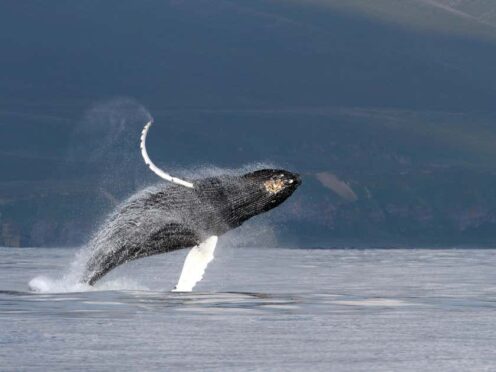
The secret to how baleen whales – the largest mammals to have ever lived – sing to each other underwater lies in their unique voice box, scientists have found.
Researchers have discovered these creatures, which include the blue whale, have unusual structures in their larynx that enables them to make sounds in a way never seen before by experts.
It is thought that baleen whales use songs – in the form of moans, grunts, thumps and knocks – to speak to each other, orient themselves and find mates.
These songs are produced at very low frequencies, of up to 300Hz, allowing them to communicate in vast oceans as low-frequency sounds are absorbed less rapidly in the marine environment than high-frequency ones.
But the team said having a unique voice box designed to make low-frequency sounds also poses a challenge for these whales, particularly when it comes to human-made noises in the ocean, which typically range between 30-300 Hz.
Researchers said that baleen whales can only communicate at a maximum depth of 100 metres below surface, which means they are likely being drowned out by the noises generated by maritime traffic.
Coen Elemans a professor at the University of Southern Denmark’s department of biology, said: “Regrettably, the frequency range and maximum communication depth of 100 meters we predict, overlaps completely with the dominant frequency range and depth of human-made noise caused by shipping traffic.”
Based on their findings, published in the journal Nature, the researchers are calling for better regulation to protect the species.
Prof Elemans added: “Compared to the seventies, our oceans are now even more filled with human-made noise from shipping lanes, drilling activity and seismic guns.
“We need strict regulations for such noise, because these whales are dependent on sound for communication.
“Now we show that despite their amazing physiology they literally cannot escape the noise humans make in the oceans.”
Baleen whales are some of the largest animals on Earth, including the blue whale, which can grow up to 30 metres (100ft) and weigh as much as 200 tonnes.
These whales have baleen plates made of keratin – the same material found in human fingernails and hair – in their mouths instead of teeth.

Since whale songs were first discovered more than 50 years ago, scientists have been trying to figure out how baleen whales produce their complex vocalisations.
For the study, the researchers researchers analysed the voice boxes of sei whales and humpback whales in the lab.
They were able to simulate how air would flow within this organ to produce sounds.
The researchers found these whales to have a large U-shaped structure made up of long cylinder-shaped tissues called arytenoids that are fused at the base.
This structure, which only exists in baleen whales, allows them to use air to generate low-frequency sounds in the ocean as well help with their “explosive” surface breathing.
Prof Elemans said: “We found that this U-shaped structure pushes against a big fatty cushion on the inside of the larynx.
“When the whales push air from their lungs past this cushion, it starts to vibrate and this generates very low frequency underwater sounds.”
He added: “Our experiments showed for the first time how the whales make their very low frequency vocalisations.”

Enjoy the convenience of having The Sunday Post delivered as a digital ePaper straight to your smartphone, tablet or computer.
Subscribe for only £5.49 a month and enjoy all the benefits of the printed paper as a digital replica.
Subscribe